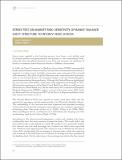Nota de Investigación
Stress test on market risk: sensitivity of banks’ balance sheet structure to interest rate shocks
Date
2017-04Abstract
Stress tests, applied to the banking system, have been a tool widely used by several private and governmental institutions at the international level, especially after the global financial crisis. This tool assesses the resilience of banks to numerous macro-financial shocks in different dimensions. In 1996, the Basel Committee on Banking Supervision (BCBS) recommended banks and investment firms to conduct stress tests to determine their ability to respond to market events. Initially, stress tests were only part of the internal self-assessment. But after the global financial crisis, some advanced economies, such as the United States, the European Union, and the United Kingdom, started stress testing for major banks. Although the Federal Reserve highlighted the use of stress tests before, these were only implemented formally in 2012 following the requirements of the Dodd-Frank Wall Street Reform and Consumer Protection Act (Dodd-Frank Act). On the other hand, the Committee of European Banking Supervisors (CEBS) conducts annual stress tests since 2009, while the Financial Policy Committee (FPC) of the Bank of England published their first stress test results in 2014.
Collections

The following license files are associated with this item:

